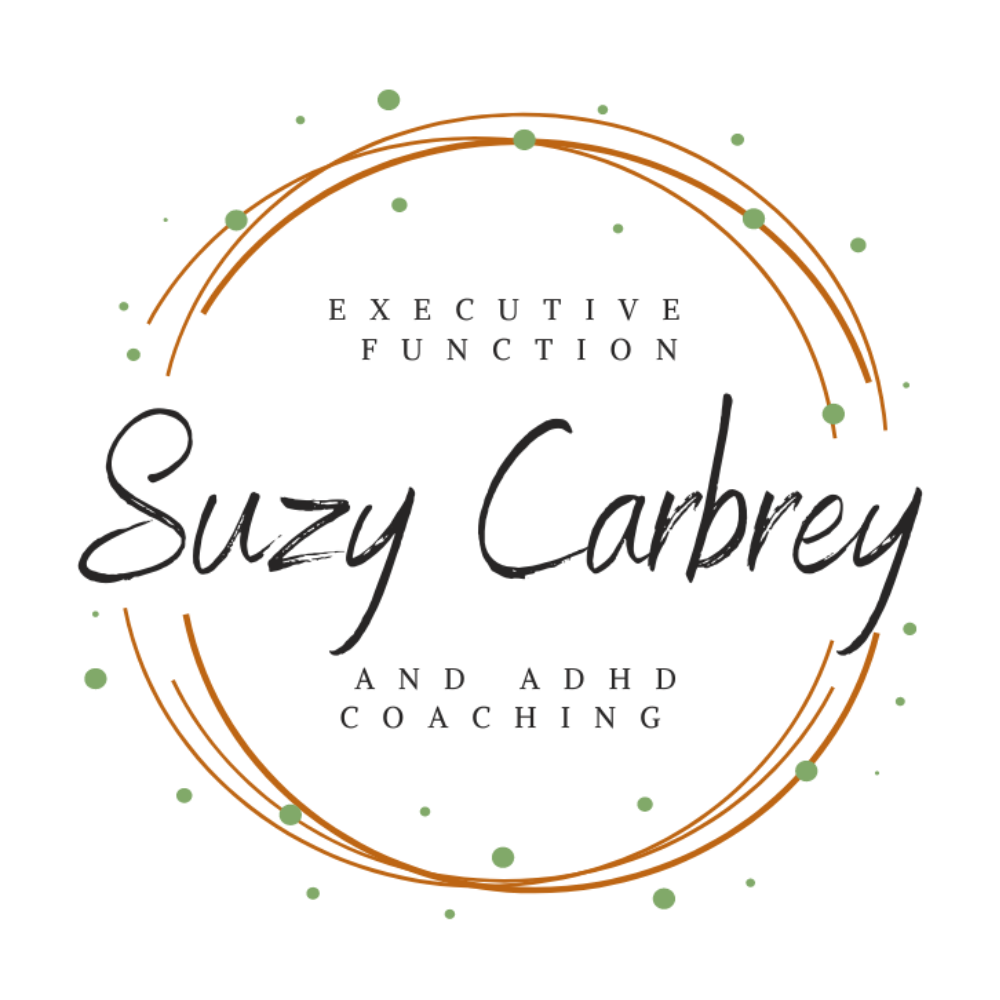External Supports for ADHD is written by Suzy Carbrey
For individuals managing ADHD or executive functioning challenges, staying on top of tasks, deadlines, and responsibilities often feels like an ongoing struggle. The mental load of keeping everything organized can be overwhelming, leading to missed deadlines, forgotten commitments, and unnecessary stress. Fortunately, one effective strategy to improve focus and productivity is externalizing information and making it visually accessible.
Externalizing involves taking information that might otherwise remain trapped in your mind and putting it into a format that you can see and interact with. This approach helps reduce cognitive overload by offloading the responsibility of remembering every detail. When you use visual aids and create organized systems, you turn abstract concepts like deadlines and to-dos into concrete, visible items that you can refer to regularly.
Visual supports such as charts, lists, and calendars provide constant reminders of your tasks and deadlines, serving as external prompts that keep you on track. By seeing these reminders frequently, you reinforce your memory and maintain focus on what needs to be done. For example, a large wall calendar in a prominent location helps you visually track upcoming events and deadlines, making it easier to manage your time effectively. Similarly, a dry-erase board filled with daily tasks and goals provides a clear snapshot of what needs to be accomplished, which can be particularly motivating.
Creating organized systems further supports this externalization by providing structured spaces for your tasks and information. This can involve setting up a command center at home with important reminders, routines, and schedules, or establishing designated landing zones for items you frequently use. These systems reduce the mental effort required to keep track of everything and make it easier to find what you need when you need it.
In essence, leveraging visual supports and external expectations transforms the way you manage responsibilities. It shifts the focus from relying solely on your memory to using tangible, visual reminders that keep you organized and on track. By implementing these strategies, you create a supportive environment that helps mitigate the challenges of executive functioning and enhances your ability to stay focused and productive.
Here’s a comprehensive guide to practical strategies that support executive functioning and make the most of visual and external aids.

Write Down Assignments and Tasks for External Supports
Keeping track of assignments and tasks by writing them down helps everyone stay organized. For students, this might mean using a notebook or app to jot down homework and project deadlines. For parents, it could involve a family calendar where everyone writes down their appointments and chores. Professionals can use a planner or digital tool to list work tasks and meetings. Regularly updating these lists ensures nothing is forgotten, whether it’s a kid’s soccer practice, a work deadline, or a family event.
Plan Out Projects for External Supports
Breaking down large projects into smaller steps makes them more manageable. For students, this means creating a timeline for a big research paper, with each step (like researching, outlining, and writing) listed and scheduled. Parents might use this method to plan family vacations, breaking it down into booking flights, creating an itinerary, and packing. Professionals can apply this by dividing a big work project into phases, such as planning, executing, and reviewing. This clear plan helps prevent feeling overwhelmed and keeps everyone on track.
Utilize Visual Timers for External Supports
Visual timers help manage time more effectively. Students can use them to break study time into focused periods, like 25 minutes of studying followed by a 5-minute break. Parents might use a visual timer to manage family activities, such as setting a timer for kids’ screen time or cooking meals. For professionals, visual timers can structure work sessions and breaks, helping to keep track of how long tasks are taking and ensuring breaks are taken. Seeing time visually helps improve focus and productivity.

Create a Command Center at Home for External Supports
A command center is a central place in the home for organizing important information. For a family, this might be a bulletin board in the kitchen where everyone posts their schedules, reminders, and important dates. For professionals working from home, a command center could be a desk area where you keep track of work tasks, deadlines, and meetings. This central hub helps everyone stay informed and organized, making it easier to manage daily activities and commitments.
Design Landing Zones for Specific Items
Creating designated spots for commonly used items helps reduce clutter. For students, this could mean having a specific place for school supplies or textbooks. Parents might set up a “landing zone” near the door for keys, mail, and bags to ensure they’re easy to find. Professionals can create an organized desk area with designated spots for office supplies, documents, and personal items. This system makes daily routines smoother and reduces the time spent searching for things.
Use Dry-Erase Boards for External Supports
Dry-erase boards are useful for tracking tasks and reminders. Students can use a board in their room to keep track of homework and project deadlines. Parents might use one in a central location, like the kitchen, to manage family schedules and chores. Professionals can keep a dry-erase board in their workspace to outline tasks, meetings, and deadlines. The ability to update and modify information quickly makes these boards a flexible tool for staying organized.

Incorporate Analog Clocks for External Supports
Analog clocks provide a clear visual of how time is passing. Students can use an analog clock in their study area to better manage their time during homework sessions. Parents might place an analog clock in the kitchen to keep track of cooking times and family activities. For professionals, having an analog clock in their office can help manage work hours and breaks, offering a visual reminder of how long tasks are taking and when to shift focus.
Ensure Easy Access to Frequently Used Documents
Keeping important documents easily accessible is crucial for staying organized. Students can use a filing system or a folder for class notes and important papers. Parents might create an organized space for household documents like bills, medical records, and school forms. Professionals should have a well-organized filing system or digital folders for work documents, ensuring they can quickly find what they need without wasting time searching.
Utilize Visual Planners or Calendars for External Supports
Visual planners or calendars help everyone keep track of schedules and deadlines. Students can use a wall calendar or planner to manage school assignments and extracurricular activities. Parents might use a family calendar to coordinate schedules, appointments, and events. For professionals, a planner or digital calendar helps track work deadlines, meetings, and projects. Regularly updating these planners ensures that important dates and tasks are visible and managed effectively.

Declutter and Simplify for External Supports
Keeping your space clean and organized reduces distractions and helps you focus. Students can declutter their study area by organizing books, supplies, and removing unnecessary items. Parents might simplify the home by keeping common areas tidy and organized, reducing stress and making it easier to find things. For professionals, a clean and organized workspace promotes productivity and reduces time spent searching for documents or supplies.
Incorporate Body Doubling and Accountability Partners
Body doubling and accountability partners boost motivation and productivity. Students can work alongside a study buddy to stay focused on homework. Parents might team up with a partner to tackle household projects or goals. For professionals, having a colleague or mentor to check in with on progress and goals can help keep tasks on track. Regular check-ins and working together with someone else can make a big difference in staying motivated and getting things done.

The Power of Visual Aids and Task Externalization for ADHD
In conclusion, embracing external supports like visual aids and task externalization can profoundly transform the way you manage ADHD and executive functioning challenges. By translating abstract concepts into concrete, visible reminders, you not only alleviate cognitive overload but also enhance your focus and productivity.
By implementing these strategies, you can create a structured and visually organized environment that supports executive functioning. Externalizing tasks and using visual aids help reduce cognitive load, improve time management, and enhance overall productivity. Remember, the key is to find and customize the strategies that work best for you and your unique needs.
Visual tools such as charts, lists, and calendars become more than just organizational aids; they become integral parts of a system that supports your daily routines and long-term goals. The strategic use of dry-erase boards, visual timers, and command centers helps you keep track of tasks and deadlines, turning the chaotic mental clutter into manageable, actionable steps.
Creating organized systems, such as designated landing zones and decluttered spaces, further reduces stress and boosts efficiency. These practices help you maintain clarity and purpose, making it easier to stay on top of your responsibilities without feeling overwhelmed.
Additionally, leveraging body doubling and accountability partners provides a valuable boost to motivation and productivity. By incorporating these strategies, you not only create a more structured environment but also build a support network that keeps you engaged and on track.
Ultimately, externalizing tasks and using visual external supports equips you with the tools to manage your responsibilities more effectively, paving the way for greater focus and accomplishment. Embrace these strategies, and you’ll find that staying organized and productive becomes not just a possibility but a rewarding reality.
Learn more about External Support with Online Coaching for Executive Functioning / ADHD
Ready to gain control and enhance your executive functioning? As an experienced and compassionate coach, I specialize in providing support for executive functioning and ADHD. To embark on your journey, please reach out to me at 708-264-2899 or email hello@suzycarbrey.com to schedule a FREE 20-minute discovery call consultation.
With a background as a speech-language pathologist, I have a strong foundation in executive functioning coaching. My graduate degree program in SLP placed a significant emphasis on cognition, including executive functions, and I have years of experience in medical rehabilitation, providing cognitive-communication therapy. Additionally, I have completed an ADHD Services Provider certification program, I am Solutions-Focused Brief Therapy Diamond Level 1 certified and I am trained in the Seeing My Time® executive functioning curriculum.
Experience the convenience and effectiveness of online coaching, backed by studies that demonstrate equal results to in-person services. Parents, professionals, and emerging adults love the convenience and privacy of receiving coaching from their own homes.
Whether you reside in Chicago, Milwaukee, Indianapolis, Kansas City, or anywhere else around the globe, I am here to assist you. Schedule your discovery call consultation today, and I eagerly anticipate the opportunity to work with you!
Please note that although I am a certified speech-language pathologist, all services Suzy Carbrey LLC provides are strictly coaching and do not involve clinical evaluation or treatment services. If you require a formal speech therapy evaluation and treatment, please inform me, and I can provide appropriate recommendations.

